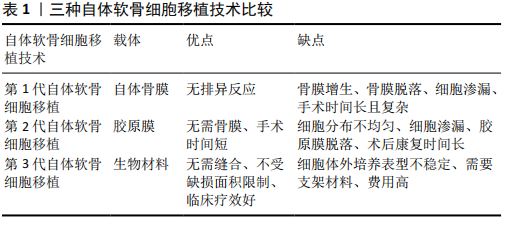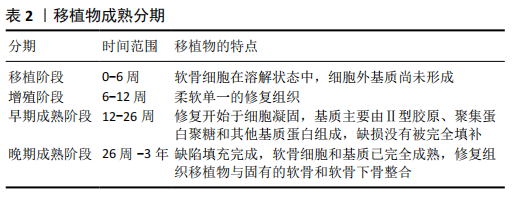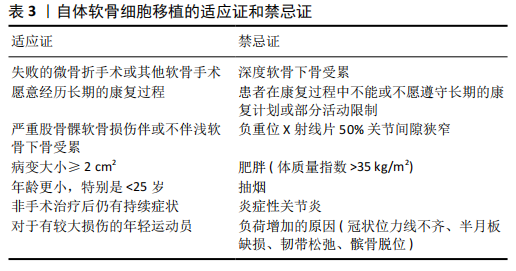[1] CAMPBELL AB, PINEDA M, HARRIS JD, et al. Return to Sport After Articular Cartilage Repair in Athletes’ Knees: A Systematic Review. Arthroscopy. 2016;32(4): 651-668.e1.
[2] KRYCH AJ, PAREEK A, KING AH, et al. Return to sport after the surgical management of articular cartilage lesions in the knee: a meta-analysis. Knee Surg Sports Traumatol Arthrosc. 2017;25(10):3186-3196.
[3] NIELSEN ES, MCCAULEY JC, PULIDO PA, et al. Return to Sport and Recreational Activity After Osteochondral Allograft Transplantation in the Knee. Am J Sports Med. 2017;45(7):1608-1614.
[4] LEPAGE SIM, ROBSON N, GILMORE H, et al. Beyond Cartilage Repair: The Role of the Osteochondral Unit in Joint Health and Disease. Tissue Eng Part B Rev. 2019;25(2):114-125.
[5] PIPINO G, RISITANO S, ALVIANO F, et al. Microfractures and hydrogel scaffolds in the treatment of osteochondral knee defects: A clinical and histological evaluation. J Clin Orthop Trauma. 2019;10(1):67-75.
[6] GREVENSTEIN D, MAMILOS A, SCHMITT VH, et al. Excellent histological results in terms of articular cartilage regeneration after spheroid-based autologous chondrocyte implantation (ACI). Knee Surg Sports Traumatol Arthrosc. 2020 Apr 10. doi: 10.1007/s00167-020-05976-9. Online ahead of print.
[7] DIBARTOLA AC, WRIGHT BM, MAGNUSSEN RA, et al. Clinical Outcomes After Autologous Chondrocyte Implantation in Adolescents’ Knees: A Systematic Review. Arthroscopy. 2016;32(9):1905-1916.
[8] NIETHAMMER TR, HOLZGRUBER M, GÜLECYÜZ MF, et al. Matrix based autologous chondrocyte implantation in children and adolescents: a match paired analysis in a follow-up over three years post-operation. Int Orthop. 2017;41(2):343-350.
[9] RUTA DJ, VILLARREAL AD, RICHARDSON DR. Orthopedic Surgical Options for Joint Cartilage Repair and Restoration. Phys Med Rehabil Clin N Am. 2016;27(4):1019-1042.
[10] DIBARTOLA AC, EVERHART JS, MAGNUSSEN RA, et al. Correlation between histological outcome and surgical cartilage repair technique in the knee: A meta-analysis. Knee. 2016;23(3):344-349.
[11] NIETHAMMER TR, LIMBRUNNER K, BETZ OB, et al. Analysis of the autologous chondrocyte quality of matrix-based autologous chondrocyte implantation in the knee joint. Int Orthop. 2016;40(1):205-212.
[12] YILMAZ EN, ZEUGOLIS DI. Electrospun Polymers in Cartilage Engineering-State of Play. Front Bioeng Biotechnol. 2020;8:77.
[13] CAO C, ZHANG Y, YE Y, et al. Effects of cell phenotype and seeding density on the chondrogenic capacity of human osteoarthritic chondrocytes in type I collagen scaffolds. J Orthop Surg Res. 2020;15(1):120.
[14] DAVIES RL, KUIPER NJ. Regenerative Medicine: A Review of the Evolution of Autologous Chondrocyte Implantation (ACI) Therapy. Bioengineering (Basel). 2019;6(1):22.
[15] ISLAM A, FOSSUM V, HANSEN AK, et al. In vitro chondrogenic potency of surplus chondrocytes from autologous transplantation procedures does not predict short-term clinical outcomes. BMC Musculoskelet Disord. 2019;20(1):19.
[16] EDWARDS PK, ACKLAND T, EBERT JR. Clinical rehabilitation guidelines for matrix-induced autologous chondrocyte implantation on the tibiofemoral joint. J Orthop Sports Phys Ther. 2014;44(2):102-119.
[17] MARTINČIČ D, MEKAČ J, DROBNIČ M. Survival Rates of Various Autologous Chondrocyte Grafts and Concomitant Procedures. A Prospective Single-Center Study over 18 Years. Cell Transplant. 2019;28(11):1439-1444.
[18] JONES KJ, CASH BM. Matrix-Induced Autologous Chondrocyte Implantation With Autologous Bone Grafting for Osteochondral Lesions of the Femoral Trochlea. Arthrosc Tech. 2019;8(3):e259-e266.
[19] MINAS T, OGURA T, HEADRICK J, et al. Autologous Chondrocyte Implantation “Sandwich” Technique Compared With Autologous Bone Grafting for Deep Osteochondral Lesions in the Knee. Am J Sports Med. 2018;46(2):322-332.
[20] YOON KH, PARK JY, LEE JY, et al. Costal Chondrocyte-Derived Pellet-Type Autologous Chondrocyte Implantation for Treatment of Articular Cartilage Defect. Am J Sports Med. 2020;48(5):1236-1245.
[21] NIEMEYER P, LAUTE V, ZINSER W, et al. A Prospective, Randomized, Open-Label, Multicenter, Phase III Noninferiority Trial to Compare the Clinical Efficacy of Matrix-Associated Autologous Chondrocyte Implantation With Spheroid Technology Versus Arthroscopic Microfracture for Cartilage Defects of the Knee. Orthop J Sports Med. 2019;7(7):2325967119854442.
[22] ZARKADIS NJ, KUSNEZOV NA, GARCIA EJ, et al. Return to Preoperative Function After Autologous Cartilage Implantation of the Knee in Active Military Servicemembers. Orthop J Sports Med. 2017;5(5):2325967117706057.
[23] NIMKINGRATANA P, BRITTBERG M. Returning to Work After Articular Cartilage Repair Intervention: A Systematic Review. Orthop J Sports Med. 2020;8(3): 2325967120905526.
[24] OGURA T, MOSIER BA, BRYANT T, et al. A 20-Year Follow-up After First-Generation Autologous Chondrocyte Implantation. Am J Sports Med. 2017;45(12):2751-2761.
[25] ALFORD JW, COLE BJ. Cartilage restoration, part 2: techniques, outcomes, and future directions. Am J Sports Med. 2005;33(3):443-460.
[26] EBERT JR, JANES GC, WOOD DJ. Post-operative sport participation and satisfaction with return to activity after matrix-induced autologous chondrocyte implantation in the knee. Int J Sports Phys Ther. 2020;15(1):1-11.
[27] CHAHAL J, ROGERS BA, GROSS AE. Surgical Approach to Articular Cartilage Repair // GAHUNIA HK, GROSS AE, PRITZKER KPH, et al. Articular Cartilage of the Knee: Health, Disease and Therapy. New York, NY: Springer, 2020:289-314.
[28] ERICKSON BJ, STRICKLAND SM, GOMOLL AH. Indications, Techniques, Outcomes for Matrix-Induced Autologous Chondrocyte Implantation (MACI). Operative Techniques in Sports Medicine. 2018;26(3):175-182.
[29] NHO SJ, PENSAK MJ, SEIGERMAN DA, et al. Rehabilitation after autologous chondrocyte implantation in athletes. Clin Sports Med. 2010;29(2):267-282.
[30] BUCHER TA, EBERT JR, JANES GC, et al. Arthroscopic Matrix-Induced Autologous Chondrocyte Implantation// FARR J, GOMOLL AH. Cartilage Restoration. New York, NY: Springer, 2018:153-160.
[31] HEVESI M, KRYCH AJ, SARIS DBF. Treatment of Cartilage Defects With the Matrix-Induced Autologous Chondrocyte Implantation Cookie Cutter Technique. Arthrosc Tech. 2019;8(6):e591-e596.
[32] PASCUAL-GARRIDO C, SLABAUGH MA, L’HEUREUX DR, et al. Recommendations and treatment outcomes for patellofemoral articular cartilage defects with autologous chondrocyte implantation: prospective evaluation at average 4-year follow-up. Am J Sports Med. 2009;37 Suppl 1:33S-41S.
[33] FARR J. Autologous chondrocyte implantation improves patellofemoral cartilage treatment outcomes. Clin Orthop Relat Res. 2007;463:187-194.
[34] BIANT LC, SIMONS M, GILLESPIE T, et al. Cell Viability in Arthroscopic Versus Open Autologous Chondrocyte Implantation. Am J Sports Med. 2017;45(1):77-81.
[35] EBERT JR, FALLON M, WOOD DJ, et al. A Prospective Clinical and Radiological Evaluation at 5 Years After Arthroscopic Matrix-Induced Autologous Chondrocyte Implantation. Am J Sports Med. 2017;45(1):59-69.
[36] ERICKSON B, FILLINGHAM Y, HELLMAN M, et al. Surgical management of large talar osteochondral defects using autologous chondrocyte implantation. Foot Ankle Surg. 2018;24(2):131-136.
[37] NIXON AJ, SPARKS HD, BEGUM L, et al. Matrix-Induced Autologous Chondrocyte Implantation (MACI) Using a Cell-Seeded Collagen Membrane Improves Cartilage Healing in the Equine Model. J Bone Joint Surg Am. 2017;99(23):1987-1998.
[38] BENTLEY G, BIANT LC, VIJAYAN S, et al. Minimum ten-year results of a prospective randomised study of autologous chondrocyte implantation versus mosaicplasty for symptomatic articular cartilage lesions of the knee. J Bone Joint Surg Br. 2012; 94(4):504-509.
[39] ZHANG C, CAI YZ, LIN XJ. Autologous chondrocyte implantation: Is it likely to become a saviour of large-sized and full-thickness cartilage defect in young adult knee? Knee Surg Sports Traumatol Arthrosc. 2016;24(5):1643-1650.
[40] HIRSCHMÜLLER A, SCHOCH W, BAUR H, et al. Rehabilitation before regenerative cartilage knee surgery: a new prehabilitation guideline based on the best available evidence. Arch Orthop Trauma Surg. 2019;139(2):217-230.
[41] KON E, FILARDO G, BERRUTO M, et al. Articular cartilage treatment in high-level male soccer players: a prospective comparative study of arthroscopic second-generation autologous chondrocyte implantation versus microfracture. Am J Sports Med. 2011;39(12):2549-2457.
[42] NIEMEYER P, KÖSTLER W, SALZMANN GM, et al. Autologous chondrocyte implantation for treatment of focal cartilage defects in patients age 40 years and older: A matched-pair analysis with 2-year follow-up. Am J Sports Med. 2010;38(12):2410-2416.
[43] FARR J, GOMOLL AH. 2016 barriers to cartilage restoration. J Clin Orthop Trauma. 2016;7(3):183-186.
[44] CVETANOVICH GL, RIBOH JC, TILTON AK, et al. Autologous Chondrocyte Implantation Improves Knee-Specific Functional Outcomes and Health-Related Quality of Life in Adolescent Patients. Am J Sports Med. 2017;45(1):70-76.
[45] EBERT JR, SMITH A, JANES GC, et al. Association Between Isokinetic Knee Strength and Perceived Function and Patient Satisfaction With Sports and Recreational Ability After Matrix-Induced Autologous Chondrocyte Implantation. Orthop J Sports Med. 2019;7(12):2325967119885873.
[46] BIANT LC, BENTLEY G, VIJAYAN S, et al. Long-term results of autologous chondrocyte implantation in the knee for chronic chondral and osteochondral defects. Am J Sports Med. 2014;42(9):2178-2183.
[47] KIM MK, PARK JS, JEON YM, et al. Clinical, radiological, and histological outcomes after the fibrin-matrix autologous chondrocyte implantation for chondral lesions of the knee in patients more than 50 years old: A prospective case series with minimum 2-year follow-up. J Orthop Surg (Hong Kong). 2020; 28(1):2309499019893509.
[48] SHARMA A, REES D, ROBERTS S, et al. A case study: Glycosaminoglycan profiles of autologous chondrocyte implantation (ACI) tissue improve as the tissue matures. Knee. 2017;24(1):149-157.
[49] RIBOH JC, CVETANOVICH GL, COLE BJ, et al. Comparative efficacy of cartilage repair procedures in the knee: a network meta-analysis. Knee Surg Sports Traumatol Arthrosc. 2017;25(12):3786-3799.
[50] DEKKER TJ, ERICKSON B, ADAMS SB, et al. Topical Review: MACI as an Emerging Technology for the Treatment of Talar Osteochondral Lesions. Foot Ankle Int. 2017;38(9):1045-1048.
[51] BASAD E, WISSING FR, FEHRENBACH P, et al. Matrix-induced autologous chondrocyte implantation (MACI) in the knee: clinical outcomes and challenges. Knee Surg Sports Traumatol Arthrosc. 2015;23(12):3729-3735.
[52] BOUSHELL MK, HUNG CT, HUNZIKER EB, et al. Current strategies for integrative cartilage repair. Connect Tissue Res. 2017;58(5):393-406.
|



